2018 Brewing Retrospective
¶ by Rob FrieselManaged to brew 30 times 1 in 2018. Some big beers, some small beers. New-to-me styles, and old favorites. My first step mashes. My first ciders. Let’s to a quick retrospective on them, shall we?

Tilde Porter
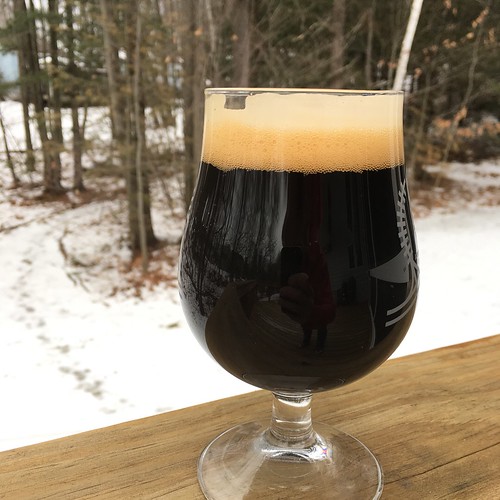
Tilde Porter! A beer brewed more or less on a whim. I’d originally formulated it for the club’s 104 Porter Clone Challenge — but I didn’t brew it in time for the (original) deadline. So then I tweaked the recipe slightly just to have for personal cold weather consumption. But then they re-opened the Clone Challenge when there was just the one entry. So I wound up entering it after all. Won the Clone Challenge, and placed 2nd for American Browns & Porters in the 2018 Noonan with a 37.5.
Prosody (Mosaic)

A combination of hubris and bad luck? Prosody (Mosaic) was the third APA in this single hop series. It was also the fifth re-pitching of that culture of yeast — and a good 83 days since that had been harvested. At the time it was judged at Noonan in May, it was cited for acetaldehyde — which was never something I picked up in it. On the other hand, I did get what I thought might be above-threshold diacetyl. A couple of things came to mind: first, that the age and generation of the yeast may have resulted in petite mutants; and second, that dry hopping with all that Mosaic may have resulted in some of that so-called “hop creep”. Probably more of the former than the latter, though wouldn’t dismiss some combination of the two. Oh well, lessons learned.
It scored a 20 in competition. This was disappointing, because the early bottles seemed so lively and good. But it wasn’t surprising, because the later bottles were so lifeless and off.
Kirkland Clover Challenge

It started as a joke. Cheap honey at CostCo? Let’s see if we can brew with that. This escalated into the Kirkland Clover Challenge. Make a 3 gallon batch of mead from 5 lb. of clover honey for $11.99. Reports from other club members was that theirs were… undrinkable. I don’t know that mine was undrinkable but it was pretty lifeless on its own. I dry hopped the heck out of it though, and that gave it some character. Scored a 37 in competition but didn’t place. Honestly surprised that it did decently at all.
Verdict on that cheap CostCo honey? It was… cheap. I’ve heard rumors that people are skeptical that it isn’t even real honey. I don’t know that I believe that — but I do believe that it’s not high-quality, and that anything that would give it an interesting flavor has been filtered out. It’s good for boosting gravity, but not much else.
Tilde Galaxy (Mk. II)

The Mk. II batch of Tilde Galaxy. I wanted to re-brew it to see if I could out-perform the previous batch in competition. (Also I love Galaxy and this was such a delicious beer the first time around.) I tried to put the 2017 judging feedback to work here. When all was said and done, this beer defended its 3rd place showing, but came in with a lower score. (Luck of the draw on judges, I guess?) I enjoyed the hell out of this beer though.
Nevertheless, between this beer and Prosody (Mosaic), my takeaway messages seem to be to use more hops and/or use an obscene amount of hops.
As a fun aside: I got a great first-hand “lightstruck” experience with this DIPA. I’d heard that a beer could skunk in the sunlight in just a matter of minutes, but I was skeptical of this claim. But in the spring, I poured some off the keg and sat on the front porch with sunlight streaming down. And wow did the aromas and flavors change dramatically in just a few minutes.
Evil Clone (Mk. II)
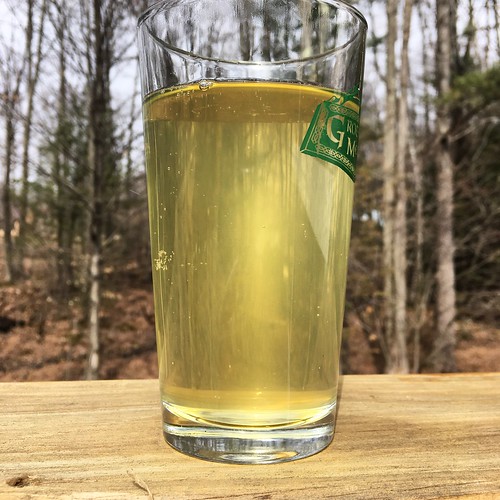
The Mk. II batch of our house’s favorite mead. Some minor tweaks from the original batch. None of those tweaks seemed particularly worth keeping. Lessons learned? EC-1118 is a powerhouse yeast, but didn’t do us any favors in the flavor department. Also: be careful with grated ginger — it’ll go everywhere you don’t want it if you don’t keep it contained.
Grünberg Pils

My first German Pils, I learned a couple of lessons while brewing Grünberg Pils. I learned that using a double layer of Reflectix helps, but not as much as I thought. I learned that straddling two burners on the stovetop and firing up both of them helps, but not as much as I thought. It was my first attempt at infusion step mashing, which was great — but I learned I needed to allow more time for the infusions to heat. I also learned I can make a serviceable German Pils because it kicked pretty damn fast at a party that we threw.
Clone in the Window

My clone of Light in the Window. Which is a little unfair to call it a clone because I managed to convince them to give me the recipe after they stopped brewing it. But that still presents its own challenges with respect to scaling down from 18.5 bbl batch size. Also my first time brewing in my garage on the propane burner. Learned that I needed to consider a much higher boil-off rate compared to what I was accustomed to in the kitchen.
Uncle Rico

First time working with corn as an adjunct was when I made the Uncle Rico cream ale. Not much to reflect on with this batch. It was brewed for the sheer drinking pleasure of it, and it didn’t disappoint.
Honestatis (Mk. VIII)

Dan was the primary brewer on what (for me) was the Mk. VIII batch. Fermented with re-pitched 1007 yeast from Uncle Rico. Was an interesting change-up; this yeast fermented super-clean and left behind almost no esters. Very much changed the character of the beer.
Glorified

Partly to try my hand at the “Trappist Single” style, but more so to build up a big colony of yeast for a future brew — Glorified took its name from the fact that it was a glorified starter. Discovered that I still needed to work on my step mash game. Bottle conditioned this beer to be “traditional” but suspect that I picked up an infection in some (but only some?) of the bottles; had at least one explode, and more than a few foam up with carbonation that was even higher than the “high” levels expected.
Partial Shade

Partial Shade was my first pyment. A lesson in why you can’t always trust “the math”. Planned an O.G. of 1.107; measured 1.123. Calculated an F.G. of 1.020 when accounting for the yeast strain’s alcohol tolerance; measured 1.001. Not that I wasn’t pleased with the results just… some lessons learned there. And maybe it’s because I used Belle Saison to ferment? And maybe there’s just more I need to learn about strains that prove to be var diastaticus?
Evil Clone (Mk. III)

And again with the house ginger mead. Mk. III batch. Walked back from a bunch of the changes from the second batch; made this one more like the first. Quick turnaround on it; also consumed quickly.
Avout

A beer that was — oh shit — almost three years in the making? Avout was to be my theorized “Belgian Red Strong”. The yeast cake from Glorified was what fermented this beer — an almost textbook case of re-pitching. This was also my taste of the challenges of a high-gravity all-grain wort production. Also my first attempt at “bottle conditioning” in the keg. Pleased overall with how this one turned out.
Hoarder Intervention #1

In the spirit of Brülosophy’s Short & Shoddy, I did my own little “lowest possible effort” beer with Hoarder Intervention #1. The main ideas here: (1) use up a bunch of leftover ingredients, and (2) try out that whole biotransformation dry hop thing. I built the beer around a motley crew of “junk drawer” ingredients: caramel rye malt, Mosaic, Motueka, and Simcoe hops. It turned out serviceable, and just goes to show you that you can slap together a decent beer. I’d never enter this one into competition, but I had no problem sharing it around.
Green Mountain Grisette (Mk. II)
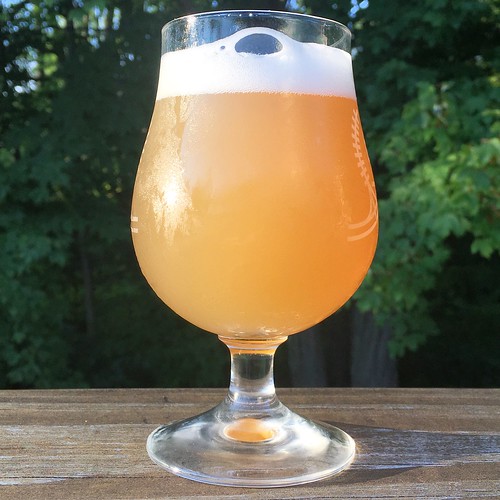
One of my greatest brewing disappointments. Green Mountain Grisette (Mk. II) was me trying to apply the judging feedback I’d gotten to improve a beer that I was already happy with. But mash efficiency was off. As was the timing of my step mash infusions. And my estimates of the boil-off rate. And I guess pitching rate? because it appeared to under-attenuate. To say nothing of the transfer problems after the dry hop that left me with multiple clogged dip tubes, and an overly astringent beer.
Putting my grisette dreams on the shelf for a little while after this.
Peraridus

Meanwhile in the everybody’s doing it department… Peraridus, my take on the club brew of Brut IPA. I was going to brew one myself, but then we all got to talking and the planned club brew was looking an awful lot like what I had in mind anyway… So I got in on it rather than do it all myself.
Thoughts on the style? Seems to me like a novelty. I like the idea of a hop-forward beer as much as the next person, but there seem to be plenty of ways to do such a thing without making a deal with the devil using enzymes. Sure, it wound up dry as a bone, but it also seemed to be missing body. Not that it wasn’t tasty.
Sunny Night

Made Sunny Night on a whim. When I did the Reflectix experiment that led to my first BYO article, 2 I had all this hot water that I didn’t want to just dump. So I rounded up some honey and black currant puree. A decent-enough melomel made with effectively no planning. A. thought it was too tart, but some other tasters that do like tart beverages enjoyed it very much. It went fast at the Jericho Brewer’s Festival.
Tilde Festbier
When the Green Mountain Mashers started planning an Oktoberfest-style dedication party for the Greg Noonan Memorial Library, I decided that I had no excuse but to make Tilde Festbier — my first attempt at the style. And though it turned out slightly stronger than intended (but only slightly) — I also felt like I got my step mash infusions right this time, and that I managed to pitch enough yeast, and that my lager fermentation technique was about right. Crisp and with that light toasty-bready quality… Set aside a few for competition, and had plenty to share for the dedication. Turns out I really like German lagers.
A Mead Has No Name

For the second year in a row, I did the AHA Mead Day mead-making demonstration for our local homebrew club; the resulting mead got the name… A Mead Has No Name. “The Point” of my demo was to make the mead-making process look as accessible as possible — or as I said during the demo: “I want to make it look like literally anyone can do this.” So I used honey you could pick up at CostCo, and I used the cheapest equipment I still had in my rotation (i.e., plastic brew buckets and a big ol’ spoon). That said, by the time it finished going from must to mead, I started to get those feelings like I could tell the difference when it came to ingredients. (Not that it was undrinkable or anything like that.)
Prosody (Huell Melon)

Huell Melon was the fourth batch of this single hop APA series, and it was definitely a case of learning just how much ingredients can matter. When I went shopping, the local HBS was out of Briess pale ale malt, so I subbed in some 2-row instead. Same story with yeast — they didn’t have 1332, so I guessed 1272 might be close enough. With respect to the former… I could see that going either way; the pale ale malt makes it seem a bit richer, but I could make up for that a bit by bumping up the Munich. As for the yeast strain… different ester profile, and 1272 seemed to need cooler temperatures. Also dry hopped this one at a much higher rate than previous batches and it wound up reading more like an IPA than an APA. Amazing what you learn sometimes.
Sirius Moonlight (Mk. II)
My second (and this time all-grain) take on my “Vienna mit Roggen” — Sirius Moonlight. This was a beer where I had good detailed tasting notes from the partial mash batch, and so could compare better — and there were some notable differences in terms of the overall character and clarity. Also tried to challenge the conventional wisdom around lagering length; mixed results there as it tasted fine while young, but definitely cleared significantly over even just an additional week. Also didn’t heed my own advice; wound up using less rye instead of more but oh well.
Hoarder Intervention #2

Second in the “junk drawer” series — Hoarder Intervention #2 was intended to use up some Patagonia Caramel 170L and Perla Negra malt samples. Plus a bunch of Centennial that was leftover from a maybe-ill-planned bulk buy. I missed my gravity, but it was hard to say whether that was the result of not having good data on the grains I used, or if I had process problems. Turned out more like a session black (or brown) IPA than the intended American brown ale — but it was a nice one to have around the house at 4.9% ABV.
Literal Fidelity
Literal Fidelity was my “straight” cider from the 2018 Chapin Crush. My first cider. Truly amazed at how simple it was to make — I mean, people told me but I didn’t believe it. Seemed to turn out fine, but we’ll see what happens with it come competition time.
Witty Pome
Meanwhile, Witty Pome was my attempt to get creative with the 2018 Chapin Crush cider. I threw in 1 lb. of brown sugar and 1.5 lb. of honey and fermented with some Witbier yeast. And maybe I need to get more familiar with cider making and the ingredients and all that because this was… well, it’s not undrinkable but it’s interesting and we’ll see what competition judges have to say about it.
Extinction Event

With the moderate success of some high-gravity beers earlier this year, I decided to try making an American barleywine with Extinction Event. I missed gravity again though, which tells me something about how I need to track these efficiencies different, I think. A decidedly warming and rich beer, but also very hoppy when I had it young. I’ve bottled a bunch, setting some of it aside to cellar. I’ve enjoyed it, but wonder if it would work better as an American Strong Ale? We’ll see how it plays in competition.
Lupulin-Industrial Complex

Living in Vermont, I never really saw a reason to brew a New England IPA — but getting my hands on 4 oz. of Comet hop hash gave me a reason. The result? Lupulin-Industrial Complex. First times here: targeting a chloride/sulfate ratio instead of a software-recommended water profile; fermenting with Omega yeast; using a “hop shot” for bittering; using hop hash as part of the dry hop schedule. Serviceable for style, and while I’ll probably try brewing another, I might stick to buying them.
Evil Clone (Mk. IV)

The Mk. IV batch — wherein I attempt to bring the gravity down a bit. As a “house” mead, I feel like having it in the 6% range makes more sense than something 7% or above. Drinkable, if a little sulfury while still young — and of course, I always want more ginger.
Bière de Garde

Trying to fit in another new-to-me beer style before the end of the year, I decided to brew a Bière de Garde. I went with a formulation in the amber color range. Turned out… at least ambrée if not bordering on brune. It has a nice malt-forward character with some toffee and dark fruit notes, but possibly missing some complexity? (I wound up calling it “Le Rousse”.)
Naked Braggot
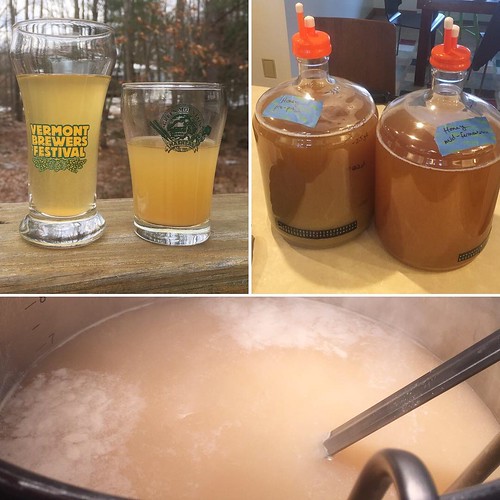
Part one in what’s likely to be a… seven (??) part series of experiments focused on exploring the braggot style space. The idea behind the so-called “Naked Braggot” was to make one as simply as possible — simple grist, simple honey… nothing complex or complicated. Still fermenting as I publish this.
Prosody (Amarillo)
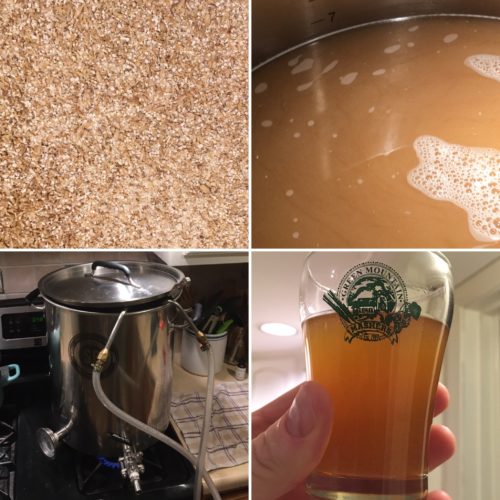
And to fit in one last (#30!) brew day for 2018, I went ahead and brewed a single hop APA around Amarillo. Mostly because I had some fresh Amarillo left over from Extinction Event and Lupulin-Industrial Complex. But also because I needed some easy-to-drink pale ale around the house. But I also just brewed it yesterday, so there’s nothing else to say about it all except…
Happy Brew Year!
- Thirty different recipes, at least. Between the beers and the meads and the ciders. We’ll call it 30.[↩]
- Paywalled! But you should go subscribe.[↩]




Leave a Reply